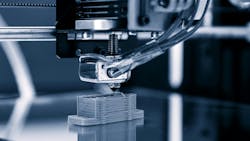Across the globe, protectionist policies are reshaping manufacturing. From tariffs on imports to reshoring initiatives, these trends reflect a growing emphasis on industrial base modernization and reducing reliance on global supply chains through local manufacturing.
Other disruptions, such as the COVID-19 pandemic and logistical crises—like the six-day container ship blockage of the Suez Canal in 2021—have also revealed vulnerabilities in global trade systems.
While the economist in me isn’t thrilled about trade barriers, I believe some of the challenges associated with these policies can be mitigated through additive manufacturing, which offers advantages in nearshoring, supply chain stability and cost-efficient production.
As we anticipate further shifts in trade policies and the potential for a broader global trade war, here are four key ways AM is poised to transform manufacturing.
Shift Toward Domestic Supply Chains
Tariffs will likely increase costs on imported goods, prompting companies to prioritize domestic manufacturing. AM’s on-demand capabilities enable rapid responses to demand changes without the complexity and delays of international supply chains. A notable example occurred during the COVID-19 pandemic, when polymerization printers were used to produce millions of nasopharyngeal swabs domestically. Leveraging AM, manufacturers were able to scale production to deliver up to 190,000 swabs per day, addressing critical shortages caused by global supply chain disruptions. AM made localized production possible, ensuring a reliable supply of essential components while reducing reliance on international logistics.
Cost Pressures and Competitive Pricing
Rising tariffs drive up prices, but AM can help reduce material waste and minimize setup time. For example, Northrop Grumman used 3D printing technology to accelerate tooling production for rocket-motor manufacturing. By leveraging AM within its tooling processes, for example—with tooling used to mold the solid rocket propellant inside the motor casing—the company reduced tooling lead times from several months to just a few weeks, allowing for faster iterations and significant cost savings.
Reshoring and High-Precision Manufacturing
AM excels in reshoring efforts, particularly for high-precision sectors like aerospace and healthcare. Its ability to create complex geometries and high-quality parts directly from digital designs surpasses the limitations of traditional methods. For example, Indaero, a Spanish aerospace supplier, adopted additive manufacturing to streamline its production of tools and flight-ready parts for aircraft. By leveraging AM, Indaero reduced manufacturing lead times by 66% and cut tooling costs by 50%. This local, high-precision production not only ensured quality but also reduced dependence on overseas suppliers, helping manufacturers maintain agility and meet stringent industry demands.
Transportation and Warehousing Efficiencies
Domestic production reduces reliance on fragile global logistics systems. AM further streamlines this process by digital inventories—where parts can be stored virtually and produced only as needed, minimizing physical storage requirements. For instance, Fathom, a U.S.-based advanced manufacturing company, leveraged AM to adopt a just-in-time manufacturing approach. By integrating AM into their prototyping operations, Fathom was able to reduce inventory by 93% and cut lead times by up to 75%. This approach not only minimized storage costs but also allowed the company to respond quickly to fluctuating customer demands, demonstrating the role AM plays in optimizing transportation and warehousing systems.
In this era of reshoring and cost-conscious production, additive manufacturing is uniquely positioned to help manufacturers navigate the complexities of protectionist policies. From ensuring supply chain stability to containing costs and reducing lead times, AM offers the flexibility and efficiency necessary to thrive in a rapidly changing global market.
About the Author

Yoav Zeif
CEO, Stratasys
Yoav Zeif has broad, global experience in industry transformation, having served in senior leadership roles for both public and private multi-billion-dollar corporations, leading worldwide operations across industries and professional domains. Zeif was president of the Americas division, head of product offering and chief commercial officer at Netafim, the world’s largest micro-irrigation company, from 2013 to 2018. Prior to that, he was senior vice president of products and marketing at Makhteshim (now Adama Ltd.), a global crop-protection company.
Zeif obtained an executive MBA from the Kellogg School of Management at Northwestern University and a Ph.D. in international economics from Bar-Ilan University
